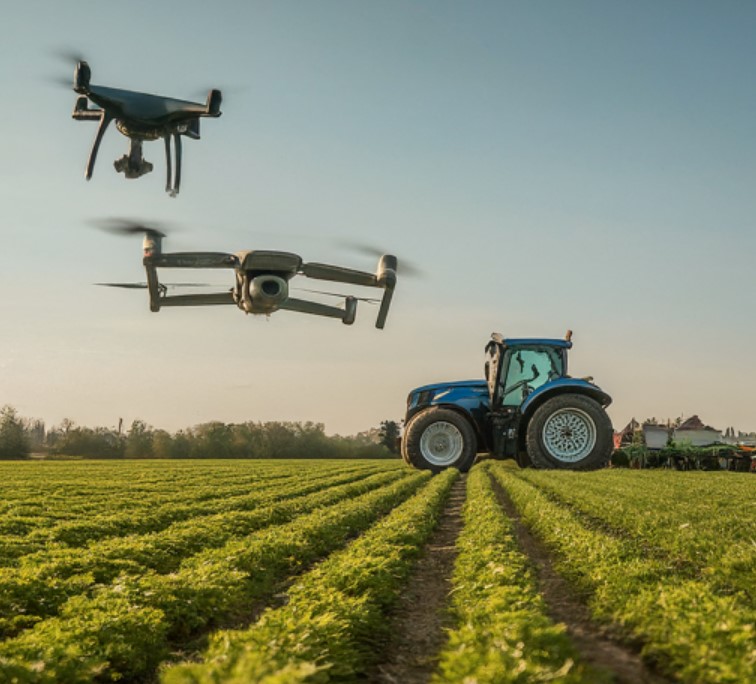(TRMB), (LNN), (NTR), (FMC), (MRK), (DE), (UAVS), (NVDA), (INTC), (AI), (ANET), (ADI), (CTVA), (BAYR), (BSWQY)
Last week, I found myself in the heartland of America, standing in a cornfield that looked like it came straight out of "Field of Dreams." But instead of ghosts of baseball players, I was surrounded by an army of tiny robots doing the work of a hundred farmhands.
"Welcome to the future of farming," grinned Bob, a third-generation farmer who looked more like a Silicon Valley tech bro than a tiller of the soil. "Those little fellas are smarter than my whole graduating class put together."
Folks, we're not in Kansas anymore. Well, actually, we were in Iowa, but you get the point.
The agricultural revolution is here, and it's powered by something called "edge AI." If you haven't heard of it yet, don't worry - your portfolio will thank you for getting ahead of the curve.
So, what's edge AI? Imagine giving every cornstalk its own personal trader, making split-second decisions based on real-time data. That's essentially what we're talking about here.
These AI-powered devices are doing everything from predicting pest outbreaks to optimizing water usage, all without phoning home to some distant server farm.
Now, I've seen my fair share of bubbles and busts over the years, but this is no dot-com pipe dream. We're talking about revolutionizing the oldest industry known to man, and the numbers are juicier than a perfectly ripe tomato.
The global agriculture market is sitting pretty at $8.3 trillion as of 2020, with projections to hit $10.1 trillion by 2026.
But here's where it gets interesting: the AI slice of this pie is growing faster than kudzu in July.
We're looking at a jump from $1.1 billion in 2020 to a mouth-watering $4.5 billion by 2026. That's a compound annual growth rate of 25.5%, folks. In trader speak, we call that "going vertical."
So, who's leading this digital barn raising? Let's break it down.
First, imagine having a personal assistant for every plant in your field. That's what companies like Trimble Inc. (TRMB) are bringing to the table. Their edge devices are like crop whisperers, monitoring everything from soil moisture to pest infestations.
Need to water? Lindsay Corporation (LNN) has got you covered with smart irrigation systems. Fertilizer? Nutrien Ltd. (NTR) is using AI to get it just right. And when pests attack, FMC Corporation (FMC) is there with AI-powered solutions.
But it's not just about the plants. Livestock management is getting a high-tech makeover too. Cows wearing Fitbits? Not quite, but close.
Allflex Livestock Intelligence, under the Merck & Co. (MRK) umbrella, is equipping animals with wearable tech. These devices track everything from health to movement patterns, helping farmers spot problems before they become disasters.
Meanwhile, the lone farmer on his tractor might soon be a thing of the past. John Deere (DE) and AgEagle Aerial Systems Inc. (UAVS) are leading the charge with self-driving tractors and drones.
These AI-powered machines can plant, harvest, and spray with pinpoint accuracy, freeing up farmers to focus on the big picture.
And it's not just agricultural companies getting their hands dirty. Tech giants are also plowing into this field, too.
For example, have you ever wondered how that apple got from the orchard to your lunchbox? IBM (IBM) is working on blockchain solutions that use edge computing to track produce from farm to table. It's about ensuring food safety and reducing waste, one data point at a time.
Meanwhile, NVIDIA (NVDA) is providing the horsepower for these AI operations, while Intel (INTC) is scattering its chips across the heartland like Johnny Appleseed on a bender.
Actually, John Deere is partnering with NVIDIA to create tractors smarter than some of the hedge fund managers I've known.
Even C3.ai (AI) is getting in on the action, offering AI software that can turn a farm into a data-driven powerhouse.
And then there are the companies working behind the scenes.
Arista Networks (ANET) provides the networking backbone that keeps all these smart devices talking to each other.
Analog Devices, Inc. (ADI) is developing the sensors that act as the eyes and ears of these AI systems.
Agricultural giants like Corteva Agriscience (CTVA) and Bayer AG (BAYRY) are exploring how to integrate these technologies into their existing products and services.
Even Bosch (BSWQY) is getting in on the action, working on IoT and edge computing solutions for the farm of the future.
Notably, a recent survey found that 52% of agribusinesses are already investing in AI technologies. That's more than half the industry.
Needless to say, the train is leaving the station, and it's time to decide if you're going to hop on or be left standing on the platform.
I'm not saying it's all smooth sailing though. We've got hurdles to clear - power-hungry AI, spotty rural internet, and the initial sticker shock for smaller farms. But remember, every great opportunity comes with its share of weeds to pull.
The potential upside? We're talking about boosting crop yields by 15%, cutting losses by 50%, and slashing water usage by 30%.
In a world racing to feed 9.7 billion mouths by 2050, those aren't just numbers - they're the difference between feast and famine.
So, here's the play: Keep your eyes on the agtech sector. Companies bridging the gap between Silicon Valley and the Corn Belt are poised for growth that could make the Dutch tulip mania look like small potatoes.
Now, if you'll excuse me, I've got a sudden craving for some farm-fresh corn on the cob. Who knows? It might have been grown by AI.


